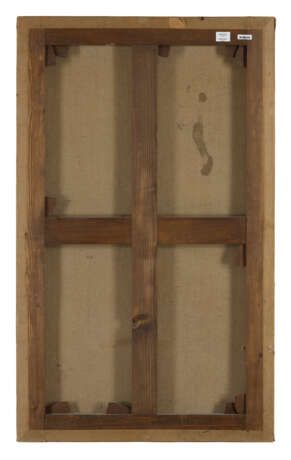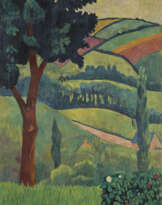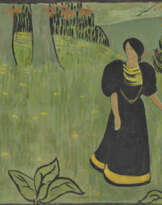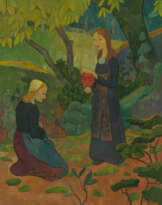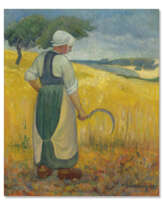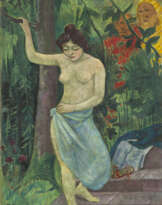ID 1051739
Lot 417 | Paul Sérusier (1863-1927)
Estimate value
€ 140 000 – 180 000
Jeune Bretonne à la faucille ou La Moisson rouge
signé et daté ‘P Sérusier 99’ (en bas à droite)
huile sur toile
92 x 58.2 cm.
Peint en 1899
signed and dated 'P Sérusier 99' (lower right)
oil on canvas
36 ¼ x 22 7⁄8 in.
Painted in 1899
Provenance
Sam Josefowitz, Pully (avant 1976).
Puis par descendance aux propriétaires actuels.
Literature
M. Guicheteau, Paul Sérusier, Paris, 1976, p. 226, no. 144 (illustré, p. 227).
Paul Sérusier et la Bretagne, cat. exp. Musée de Pont-Aven, Pont-Aven, 1991, p. 16 (illustré).
C. Boyle-Turner, Sérusier et la Bretagne, Douarnenez, 1995, p. 110 (illustré en couleurs, p. 111).
Further details
De 1896 jusqu'à sa mort, trente et un ans plus tard, la carrière de Sérusier oscilla constamment entre son désir d'explorer des principes logiques sur la ligne et la couleur, et son profond attachement à la Bretagne. L'étude de l'art égyptien, des peintres primitifs italiens et des canons de Beuron stimulèrent son esprit théorique et l'incitèrent à continuer de peindre ses sujets médiévaux. La Jeune bretonne à la faucille par exemple, qui date de 1899, représente une femme vêtue du costume de Châteauneuf-du-Faou. Sa coiffe, cependant, ressemble à la "capote" noire du Pouldu, augmentée d'un bord décoré d'inspiration médiévale. Si le tableau se contentait de reproduire le costume de 1899, il pourrait être décrit comme une simple scène de fenaison avec les meules de foin séchant dans le champ. Mais l'intemporalité du costume de la femme fait penser à un thème plus universel; peut-être est-ce une représentation de la mort, tenant sa faux prête?
Si on compare cette Jeune Bretonne à la faucille à la Jeune Bretonne tricotant [un bas rose], signée et datée de 1920, on constate que le style de Sérusier a très peu changé en vingt-et-un ans. Les deux toiles montrent une jeune femme au menton pointu, triste, vue de trois-quarts. Elle occupe dans les deux cas une moitié de l'espace pictural, la limite intérieure de sa silhouette marquant le centre de chaque tableau. Les collines de Châteauneuf-du-Faou s'élèvent dans le lointain, transformant l'arrière-plan en une série de lignes doucement incurvées. Les canons de Beuron ont dicté les angles formés par les mains, mais ils sont légèrement moins prononcés que dans les œuvres antérieures, datant de l'époque où Sérusier était plus proche des idées de Lenz. De plus, dans les deux tableaux, la gamme de tons est extrêmement limitée»
(C. Boyle-Turner, Sérusier et la Bretagne, Douarnenez, 1995, p. 110).
From 1896 until his death thirty-one years later, Sérusier's career oscillated constantly between his desire to explore logical principles of line and colour and his deep attachment to Brittany. The study of Egyptian art, Italian primitive painters and Beuron's canons stimulated his theoretical mind and encouraged him to continue painting his medieval subjects. For example, Jeune bretonne à la faucille, dated 1899, portrays a woman dressed in the costume of Châteauneuf-du-Faou. Her headdress, however, resembles the black "capote" typical of Le Pouldu, with the addition of a medieval-inspired decorated brim. If the painting simply reproduced the 1899 costume, it could be described as a banal haymaking scene with haystacks drying in the field. Yet, the timelessness of the woman's costume suggests a more universal theme; perhaps it is a representation of death, holding its scythe ready?
Comparing this Jeune Bretonne à la faucille with the Jeune Bretonne tricotant [un bas rose], signed and dated 1920, shows that Sérusier's style has changed very little in twenty-one years. Both paintings show a young woman with a sad, pointed chin, seen from three-quarter view. In both cases, she occupies half of the pictorial space, the inner edge of her silhouette marking the centre of each painting. The hills of Châteauneuf-du-Faou rise in the distance, transforming the background into a series of gently curved lines. Beuron's canons dictated the angles formed by the hands, but they are slightly less pronounced than in the earlier works, dating from the period when Sérusier was closer to the ideas of Lenz. Moreover, in both paintings, the range of colour is extremely limited" (C. Boyle-Turner, Sérusier et la Bretagne, Douarnenez, 1995, p. 110).
| Artist: | Paul Sérusier (1864 - 1927) |
|---|---|
| Applied technique: | Oil on canvas |
| Genre: | Portrait |
| Auction house category: | Paintings |
| Artist: | Paul Sérusier (1864 - 1927) |
|---|---|
| Applied technique: | Oil on canvas |
| Genre: | Portrait |
| Auction house category: | Paintings |
| Address of auction |
CHRISTIE'S 9 Avenue Matignon 75008 Paris France | ||||||||||||||
|---|---|---|---|---|---|---|---|---|---|---|---|---|---|---|---|
| Preview |
| ||||||||||||||
| Phone | +33 (0)1 40 76 85 85 | ||||||||||||||
| Fax | +33 (0)1 40 76 85 86 | ||||||||||||||
| Conditions of purchase | Conditions of purchase | ||||||||||||||
| Shipping |
Postal service Courier service pickup by yourself | ||||||||||||||
| Payment methods |
Wire Transfer | ||||||||||||||
| Business hours | Business hours
|

